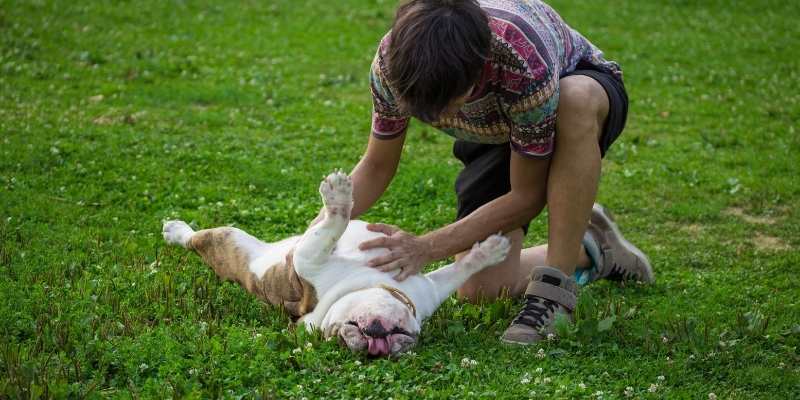More people own dogs than any other animal, and they make for fantastic pets. They love to play, and that comes with an array of benefits for it. They love having their bellies rubbed, running around, and simply licking and jumping all over you.
However, there’s one kind of play that we are familiar with as humans, but you might be asking yourself whether that applies to dogs too. Because, really, are dogs ticklish?
Do you have a specific question about dogs and tickles? Then use the table of contents below to jump to the most relevant section. And you can always go back by clicking on the black arrow in the right bottom corner of the page. Also, please note that some of the links in this article may be affiliate links. For more details, check the Disclosure section at the bottom of the page.
Here's what we'll cover:
Can dogs be ticklish?

Probably yes. But before you can answer this with 100% certainty, you need to define what tickling is. If you consider tickling to be a touch that produces a sudden involuntary movement, then the answer is yes! Dogs absolutely can be ticklish!
Being ticklish comes with laughter in humans, but that is something that dogs obviously cannot do. But tickling a dog can definitely result in some involuntary twitches or movements. So, once again, that’s a yes! Dogs can be ticklish.

Why do dogs have tickle spots?
It’s hard to say why dogs have tickle spots. It’s similar to us not really understanding why we are ticklish in the first place. It is known that it is a completely involuntary reaction, similar to us laughing and thrashing about when our ribs get tickled. If you’re trying to imagine what this reaction looks like in canines, think about scratching a dog’s belly.

It almost always comes with one leg paddling back and forth because they love it so much. That’s a tickle spot. This response is even used by veterinarians to check for proper nerve response.
These spots tend to be places that your dog can’t reach on their own. It is possible that they have become more sensitive simply because they are out of reach, and having someone else give that dog tickle spot a scratch can be very pleasing!

Are dogs’ paws ticklish?
Absolutely! Once again, they are similar to humans in that some dog’s ticklish spots are more sensitive than others. Some people will writhe and squirm if you so much as touch the soles of their feet, and others can keep a straight face. It is the exact same thing with dogs! Look at this cute guy, for instance! So, yep! Dogs’ paws are ticklish spots for them.

Where are dogs ticklish?

There are some common areas where you can find dogs tickle spots, but it is different for each canine. However, common areas are the paws, its belly, and right between the two front legs. However, if you really set out to, you can find those tickle spots with a little determination and patience. All you need to do is follow a few steps, which I have listed for you below:
- Observe your dog closely. You know the places that it tends to scratch frequently, but those are the least likely to be tickle spots. Look for regions that it seems to struggle to reach. If you ever see your dog trying its best to scratch the top of its head of its chest, then it could be a tickle spot.
- If you haven’t had the chance to observe the dog over a long time or don’t have that time to spare, you can do what I call a ‘manual’ search for the tickle spots. You just need to move your hand across your dog’s body. As you do this, look out for any reaction that it might have, such as whining, twitching, or jerking motions. If you see any of these, you might likely have just run over one of your dog’s tickle spots!
- You can also choose to go straight for the most common tickle spots if you don’t have enough time or the patience to search all over your pal’s furry body. These areas tend to be the paws, behind their ears or between the eyes, on the soft part of their belly. Or even the space under their neck and between their front legs. Look out for the telltale kick of the back legs!

How to tickle a dog?
Like many things, there is an excellent technique for tackling your dog. If you do it well on the right spots, you’re almost certain to evoke a reaction from your ticklish dogs. You have to pinpoint one of your dog’s tickle spots, and using your fingers, scratch lightly on it.
For the paws, you can simply use the tips of your fingers to rub against the soft part of their paws. Scratching can be a lot more uncomfortable on that part of their body. When you scratch, apply only a little pressure. Not more than you’d use when petting any other part of the dog’s body.
Even in humans, sometimes the lighter tickles are the most potent. Just think of a feather lightly grazing the sole of your foot!
The best time to tickle your dog is when it is calm and relaxed. E.g., after playing outside the whole day. You hitting those tickle spots just right is the perfect treat for them to end the day with, after all, so don’t be shy. They absolutely love it, after all!
Thanks for the blog graphics: Canva.com


